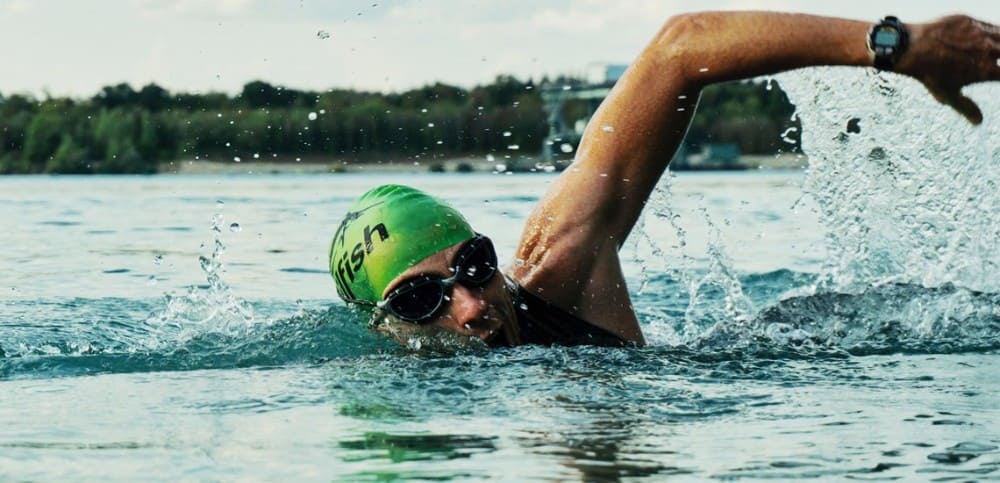How To Swim: Swimming Strokes, Styles & Techniques
Swimming is a widely loved low-impact exercise for people of all walks of life. As popular as it is, many swimmers aren’t aware of the health benefits of learning different swimming strokes. Swimming is an excellent way to achieve your fitness goals whilst having fun!
When it comes to mastering the best swimming techniques, it can be challenging, especially for beginners.
To help you get started, we’ve compiled a complete “learn how to swim for adults” guide to improve your swimming skills through new swim strokes.
Whether you’re looking to learn how to swim for the first time or looking to improve your existing techniques, this article will give you the information you need to start making a splash.
Let’s dive (pun intended) in!
The Benefits of Swimming
For swimming, there are far too many health benefits to list them all, but below are a few notable ones:
-
Swimming promotes cardiovascular health by increasing your heart rate, strengthening your heart muscle, and lowering your blood pressure to reduce the risk of heart disease.
-
Swimming exercises your whole body, making it an incredibly unique and effective practice for a full-body exercise.
-
Swimming builds endurance and muscle strength.
-
Swimming helps you maintain a healthy weight.
-
Swimming helps you control your breathing, improving your respiratory health and increasing your lung capacity to improve oxygen flow to your muscles.
Studies that focused on swimmers and non-swimmers have shown that:
-
28% have shown a reduction in all causes of mortality
-
41% have shown a reduction in cardiovascular causes of mortality.

Important Swimming Strokes and Styles
As you can likely tell from the above information alone, swimming is an incredible hobby to enjoy that’ll keep you fit, and healthy while having a blast.
Read on to discover more about crucial strokes everyone should learn and about the different swimming styles you should know to dive deeper into the world of swimming;
Freestyle
Often considered the fastest swimming style for competitive swimmers (though the butterfly stroke is a serious contender), freestyle swimming is often the first style that comes to mind when people think of swimming strokes.
Also referred to as the front crawl, freestyle swimming is performed when the swimmer lies on their stomach with their body parallel to the water. The swimmer propels themselves forward by fluttering their legs and alternating their arm movements in a windmill motion.
Freestyle is an excellent stroke to learn for both professionals and beginners alike, as it helps you swim longer without exhaustion.
Top Tip: When performing the front crawl, time your breaths to align with your swimming strokes. Also be sure to turn your head to the side when your arm is above the water, but avoid turning your head too far one way, as this can mess up your rhythm.
Backstroke
The backstroke is similar to freestyle swimming in many ways. Also known as the back crawl, the backstroke involves the swimmer floating on their back while alternating their arms in a windmill motion to propel themselves backward in the water. As the swimmer moves their arms, they flutter their legs to move through the water.
When performing the backstroke technique, your face will remain above water. This stroke is brilliant for people with back problems or anyone who hasn’t perfected breathing while mainly swimming underwater.
Fun Fact: The backstroke also strengthens your spine and can improve your posture, making it a popular choice for adults wondering how to learn swimming techniques.
Elementary Backstroke
This stroke is a variation of the traditional backstroke and involves a reversed breaststroke kick while keeping your arms underwater and in sync with each other.
The elementary backstroke gets its name because it’s considered a relatively easy technique and is commonly taught as one of the first swim styles for individuals who are entirely new to swimming.
Butterfly
This stroke is considered more advanced than strokes like the freestyle and can provide a thorough workout if you’re looking to get your blood pumping. The butterfly is perfect for a combination of exercise and fun but can be a challenge to learn and perfect. Don’t worry! With proper instruction and lessons, you’ll grow to love the butterfly.
The butterfly is performed by lying horizontally on your stomach in the water, then moving both of your arms over your head and moving them in a circular motion, pushing into the water to move your body forward. As you repeat this process, your head and shoulders come above the surface while your legs perform a dolphin kick.
The dolphin kick means that your legs must stay together and straight while kicking underwater, and it gets its name from its similarities to how a dolphin’s tail and lower body move.
Top Tip: When lifting your head above water to breathe during the butterfly technique, keep your head straight and avoid turning it to the side like you would with other strokes.
The butterfly stroke requires a learning curve and effortless coordination, but it’s perfect for individuals who want to learn to swim and advance in their techniques over time.
Breaststroke
The breaststroke is a common stroke familiar to beginners and professionals alike. This stroke is fantastic for strengthening your cardiovascular health without too much exertion.
During this stroke, the individual moves their arms and legs simultaneously, coordinating their movements as they propel themselves through the water.
In the breaststroke, the swimmer has their stomach facing the water while their arms move beneath the surface, pushed out in front of them in a half-circular motion. The swimmer also performs a whip kick by pulling their legs toward them and pushing out in a frog-like movement.
The breaststroke is also ideal for beginners who aren’t comfortable with advanced breathing techniques, as it allows them to keep their heads above water.
As the swimmer becomes more familiar with the breaststroke, they can experiment with submerging their heads at designated times.
Sidestroke
While the sidestroke isn’t a technique used competitively, it’s essential for remaining safe while swimming. Lifeguards often use the sidestroke during rescues, allowing the swimmer to pull something or someone along with them.
During the sidestroke, you propel yourself forward while lying on your side and moving your legs in a scissor motion. One arm stretches above your head while your second arm reaches to meet the first arm in front of your chest. The second arm reaches behind your body, while your first arm reaches above your head. A proper sidestroke requires your arms to move simultaneously, one going back and one moving forward.
The sidestroke can be difficult if you’re entirely unfamiliar with its movement style. However, a professional swim instructor can provide comprehensive lessons to ensure you master the sidestroke.
Tips to Master Different Swimming Strokes
Learning to swim is important for everyone and can be a fun activity with the right approach. As you learn about the many different swimming strokes and perfect the art of swimming, keep in mind the following tips:
-
Start with the basics: Before you try to swim different strokes, make sure you have a good grasp of the basics, like floating, breathing, and kicking. If you’re new to swimming, start with an easier stroke, such as freestyle or elementary backstroke.
-
Focus on breathing: Speaking of the basics, when you’re swimming, breathing can be a challenge. Ensure you exhale underwater and inhale above water, and take your time to get the rhythm right.
-
Practice arm strokes: Every swimming style has a unique arm stroke; mastering these techniques takes time and patience. Take the time to practise each stroke’s arm stroke and develop a smooth and efficient technique.
-
Get feedback: Swimming with different strokes can be tricky, and getting feedback from an experienced swimmer or coach is often helpful. They can help you identify areas for improvement and give you tips on refining your technique.
-
Stay relaxed: Tension can make swimming harder, so stay relaxed in the water. Focus on breathing deeply, keep your movements smooth, and don’t push yourself too hard.
-
Be patient: Swimming with different strokes takes time and practice, so be patient with yourself. Learn the movements slowly and methodically to progress quickly. Celebrate small victories, and don’t get discouraged by setbacks. Like anything, mastering different swimming strokes is a learning curve.
-
Enjoy the process: Swimming is fun and rewarding, so enjoy learning and improving your skills. You’ll be swimming with different swim strokes in no time with practice and dedication.

Master the Art of Swimming With Village Gym
Going to the gym is a great way to keep yourself active with fun exercises like swimming. The enticing, heated indoor pools at Village Gym will provide you with the best environment to practise different swimming strokes and styles and start making a splash.
Village Gym offers swimmers the ideal environment to tailor exercise to their preferences. Enjoy a dedicated swim lane to train on yourself or take a dip to relax after a hectic day. If you’re learning to swim, consider our swimming lessons and helpful courses like Float Fit and Aqua Aerobic classes. No matter your swimming needs, we’ve got you covered.
Check out Village Gym today for more or visit your local gym for a tour or a day pass.


